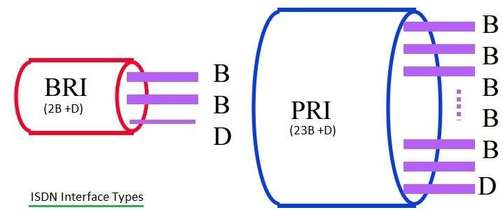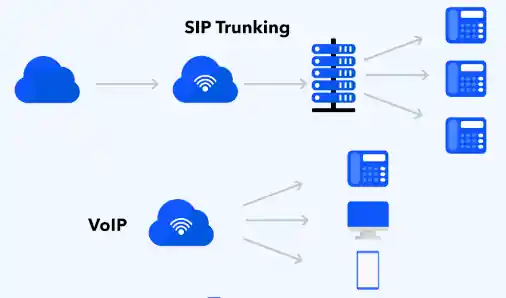The Primary Rate Interface for Integrated Services Digital Network (PRI-ISDN) once stood as a cornerstone in telecommunications, providing a structured, high-capacity digital communication channel within ISDN systems. In this retrospective exploration, we will delve into the concept of PRI-ISDN, elucidating its configuration, historical significance, and the transition to more contemporary technologies that have succeeded its utility.
- What is PRI-ISDN?
- The Legacy Architecture of PRI-ISDN
- The Decline of PRI-ISDN Usage
- Understanding Modern Alternatives to PRI-ISDN
- Conclusion
- References
1. What is PRI-ISDN?
Historically, PRI-ISDN was a premier solution for achieving high-volume and reliable digital transmission, comprising 23 B channels and one D channel, known as 23B+D. With each channel transmitting at 64 Kbps, it paralleled the capacity of a T1 circuit, offering a total bandwidth of 1.544 Mbps. This structure allowed for the aggregation of B channels to create a singular, powerful data channel, optimizing digital communication capabilities.
The European counterpart of PRI-ISDN extended its capabilities further, employing 30 B channels alongside a single D channel, thus matching the bandwidth of an E1 circuit. Despite its advanced functionality for the time, the rise of more efficient, scalable, and cost-effective technologies has led to the phasing out of PRI-ISDN in modern telecommunications infrastructures.
The B channels carry the voice or data between the customer premises and the telco’s central office (CO), while the D channel is used for establishing connections and signaling.

The bandwidth of each B channel and of the single D channel is 64 Kbps, so the total bandwidth of PRI-ISDN is 1.544 Mbps, which is identical to that of a T1 circuit. By using the bonding protocol, the 23 B channels can be combined to form a single 1.472-Mbps data channel. The European version of PRI-ISDN uses 31 B channels and one D channel, providing the bandwidth of an E1 circuit.
2. The Legacy Architecture of PRI-ISDN
PRI-ISDN’s architecture was a paragon of digital transmission during its heyday, ingeniously structured to optimize telecommunication networks. Central to its design were the 23 Bearer (B) channels, each providing a 64 Kbps conduit for voice and data. Consequently, these channels facilitated simultaneous conversations or data transfers. Furthermore, the single Delta (D) channel, also at 64 Kbps, was dedicated to control and signaling, rather than the conveyance of user data. This separation of services allowed for uninterrupted signaling, independent of the user channels’ load, thereby enhancing efficiency.
This configuration was not only robust but also versatile. The bonding of B channels to form an integrated data stream elevated the potential throughput to an impressive 1.472 Mbps, mirroring the speed of a T1 line. Conversely, the European standard boasted 30 B channels and one D channel, offering the higher bandwidth of an E1 circuit.

PRI-ISDN’s legacy is etched in its capability to support complex digital services, including video conferencing, high-speed internet, and advanced voice services. This infrastructure catered to businesses requiring vast communication channels, thus propelling PRI-ISDN to a position of historical prominence in the telecommunications sphere.
3. The Decline of PRI-ISDN Usage
The decline of PRI-ISDN is a tale of technological evolution. Foremost, the advent of the Internet and the proliferation of broadband technologies dramatically altered the telecommunications landscape. Broadband services offered faster speeds, greater scalability, and cost advantages that PRI-ISDN could not match. Moreover, the industry’s gravitation towards packet-switched networks, epitomized by Voice over Internet Protocol (VoIP) technology, signaled a fundamental shift away from the circuit-switched foundation upon which PRI-ISDN was built.
Additionally, market dynamics played a pivotal role. The demand for higher bandwidth and more flexible communication solutions grew exponentially. Businesses sought infrastructures that could easily adapt to changing needs without the inherent limitations of PRI-ISDN’s fixed channel structure.
Lastly, the introduction of dynamic and integrated services, such as SIP trunking, provided seamless integration with cloud services, unified communications, and the burgeoning Internet of Things (IoT) ecosystem. These factors, coupled with the reduction in operational expenditures and the promise of future-proofing networks, ushered in a new era, rendering PRI-ISDN a relic of the past.
Thus, PRI-ISDN’s decline was an inevitable consequence of progress, a natural outcome in the relentless march towards more sophisticated, efficient, and cost-effective communication technologies.
4. Understanding Modern Alternatives to PRI-ISDN
As the digital communication landscape has evolved, alternatives like Voice over Internet Protocol (VoIP) and Session Initiation Protocol (SIP) trunking have emerged, ushering in a new era of efficiency and flexibility.

VoIP is a transformative technology that transmits voice communications and multimedia over Internet Protocol (IP) networks. This paradigm shift from the traditional circuit-switched networks to packet-switched networks represents a leap in functionality and scalability. Unlike PRI-ISDN, VoIP can dynamically allocate bandwidth, significantly reducing wastage and increasing efficiency. Moreover, VoIP is inherently more adaptable, capable of integrating with a broad spectrum of modern communication applications and services.
SIP Trunking is another avant-garde solution that has outpaced PRI-ISDN. It leverages the SIP standard to establish, manage, and terminate multimedia communication sessions. This enables devices to engage in voice, video, and messaging applications across a myriad of platforms. SIP trunking offers a compelling advantage over PRI-ISDN by providing scalability that can be adjusted to match the ebb and flow of business needs. The elasticity of SIP supports the modern workforce’s requirements, including remote collaboration and unified communications, all while curtailing costs.
These modern technologies collectively offer a cornucopia of benefits, including cost savings, simplified infrastructure, and enhanced disaster recovery capabilities. Furthermore, the transition from PRI-ISDN to these cutting-edge alternatives was driven by a strategic pursuit of innovation, efficiency, and competitiveness in a global market.
5. Conclusion
In conclusion, the journey from PRI-ISDN to contemporary communication solutions reflects the inexorable progress of technology. PRI-ISDN, once a bulwark of digital communication, has been superseded by more versatile and cost-effective alternatives. Understanding this transition is pivotal for businesses seeking to modernize their communication infrastructure. Finally, by embracing VoIP and SIP trunking, organizations can position themselves at the forefront of communication technology, ready to leverage the full spectrum of digital possibilities.
6. References
- “Voice over IP Fundamentals” – Jonathan Davidson, James Peters, Brian Gracely
- “SIP: Understanding the Session Initiation Protocol” – Alan B. Johnston
- RFC 3261 – SIP: Session Initiation Protocol
- RFC 3550 – Standard 64: RTP: A Transport Protocol for Real-Time Applications
- Basic Rate Interface ISDN (BRI-ISDN)
- Integrated Services Digital Network (ISDN)